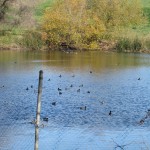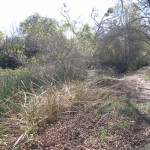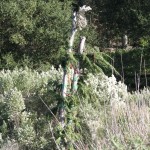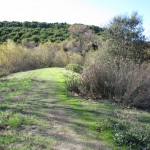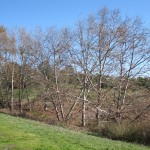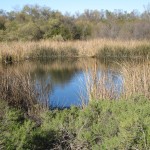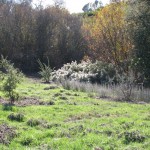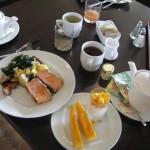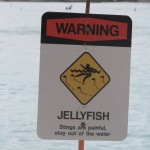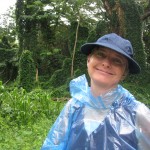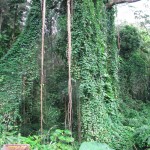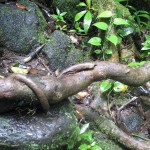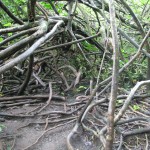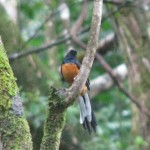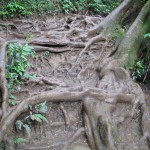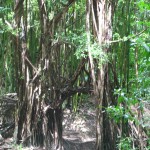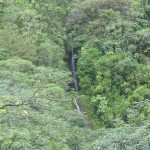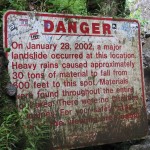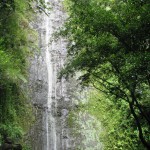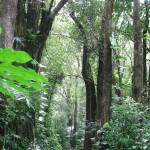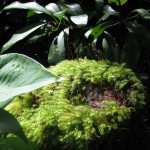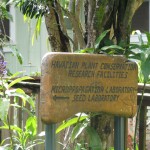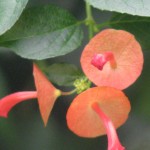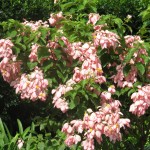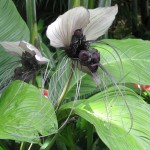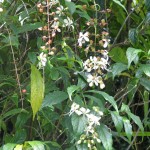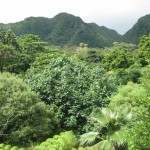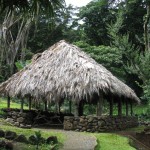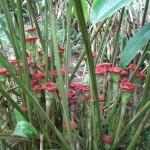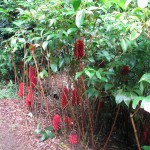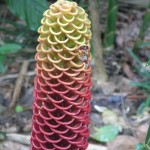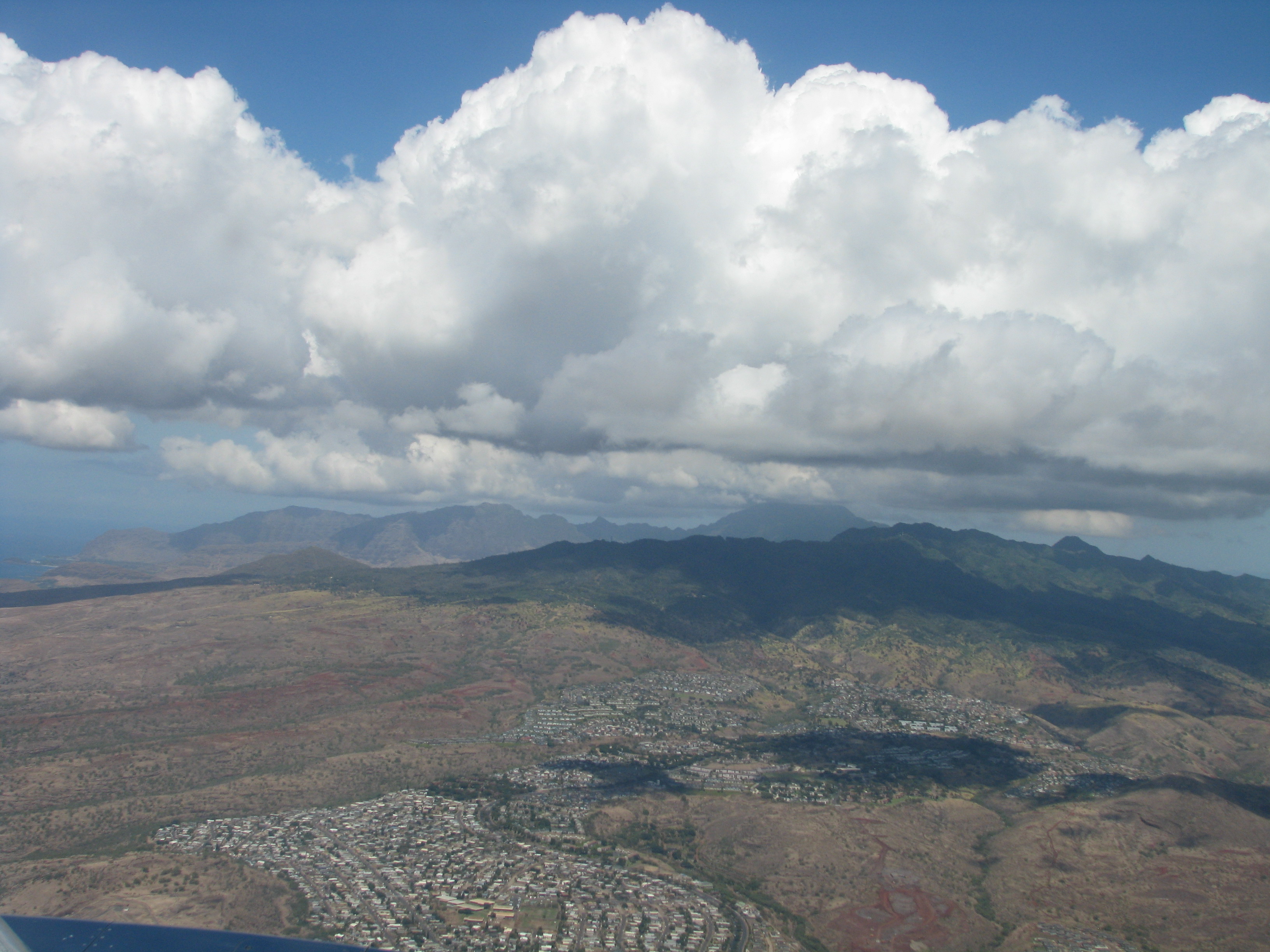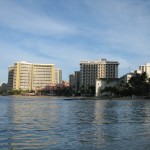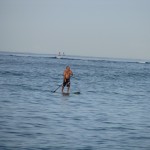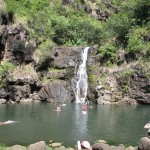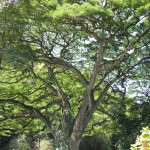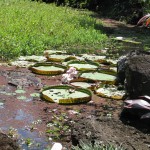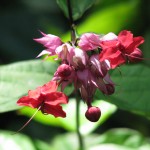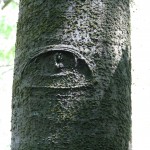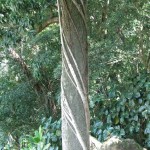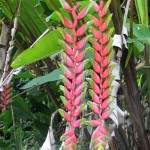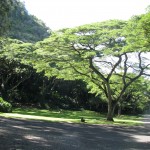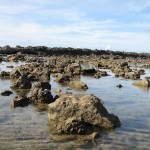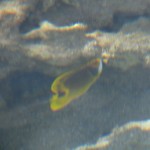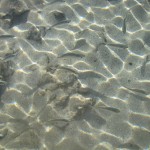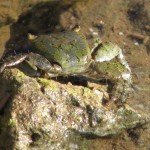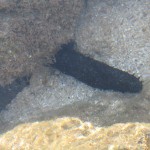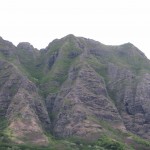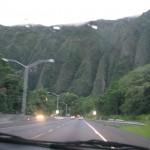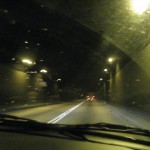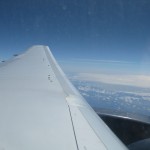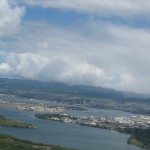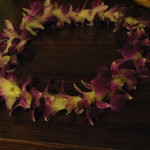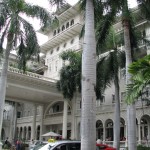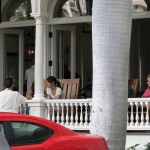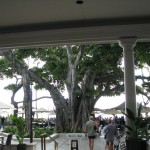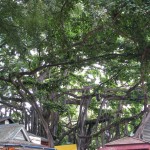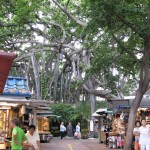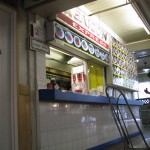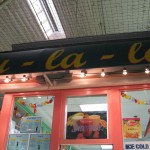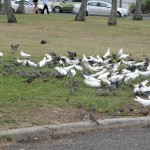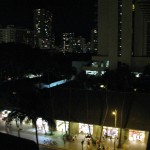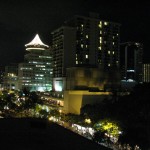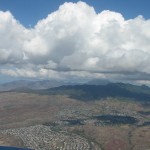Travel
Excursions to exotic locales or day tripping, I realize that humor and motion sickness pills are the best companions.
- Animals, Compost, Gardening adventures, Giving, Health, Hiking, Houses, Natives, Natural cleaners, Permaculture and Edible Forest Gardening Adventures, Planting, Recycling and Repurposing, Water Saving
The Ethics of Permaculture, and Getting Through Disastrous Times
 The three main ethics of permaculture, according to the late Bill Mollison who wrote the Permaculture Design Manual, are 1. Care for the Earth, 2. Care for People 3. Return of Surplus. These ethics are what keep me soundly grounded in permaculture, and what we humans need to embrace in our everyday lives especially now in the face of environmental disaster. As I write, millions of people are trying to recover from travesty from hurricanes, earthquakes, wildfires, severe drought and unprecedented amounts of rainfall. That is above the starvation and political unrest that is ongoing. What is also happening to the millions of species of animals and insects, not to even think about all the domestic animals and livestock, who are also victims of these disasters isn’t even in most people’s thoughts. We live in the Anthropocene epoch, which means that now humans and human action determine the fate of everything else on earth. We have that much power. We are children driving a double-shift semi on a busy freeway going the wrong way.
The three main ethics of permaculture, according to the late Bill Mollison who wrote the Permaculture Design Manual, are 1. Care for the Earth, 2. Care for People 3. Return of Surplus. These ethics are what keep me soundly grounded in permaculture, and what we humans need to embrace in our everyday lives especially now in the face of environmental disaster. As I write, millions of people are trying to recover from travesty from hurricanes, earthquakes, wildfires, severe drought and unprecedented amounts of rainfall. That is above the starvation and political unrest that is ongoing. What is also happening to the millions of species of animals and insects, not to even think about all the domestic animals and livestock, who are also victims of these disasters isn’t even in most people’s thoughts. We live in the Anthropocene epoch, which means that now humans and human action determine the fate of everything else on earth. We have that much power. We are children driving a double-shift semi on a busy freeway going the wrong way. Instead of sinking into depression and denial, every one of us can make subtle changes that will help. Understanding these permaculture ethics and putting them to work in our homes, our gardens and our workplace WILL help, and will influence others to do the same.
When I was a very easily-influenced young person, the church our family went to began a campaign around the slogan: God first, Others Second, Me Third. I took that to heart, and being naive, it also made me into a doormat for anyone with a stronger personality than me, which was practically everyone. This slogan serves the church by demanding support, instills guilt and creates identity issues. I didn’t realize that until decades later. What would have happened in my life if I’d have known about permaculture when I was in college? If I’d heard and embraced the three life-giving ethics then? Without caring for the earth, we have nothing. Did you know that over half of the oxygen we breath is created by phytoplankton in the ocean? And that all those insecticides and herbicides that are sprayed in backyards and on crops run into the ocean and are killing the phytoplankton at enormous rates? Trees and plants provide the rest of our oxygen, and with deforestation, desertification, and out of control weather catastrophies trees are dying. People are not replanting trees at a rate that will help. So where will our oxygen come from, if our first ethic is not Care for the Earth? The church’s slogan sounds devout, but it doesn’t focus on real world issues. It makes religion the most important thing rather than keeping religion in your heart as you help in practical ways. You can belong to almost any religion and embrace permaculture ethics. They work well together.
Care for People: in this world dominated by humans and connected by media it is amazing how frightened so many of us are of anyone who looks or acts slightly different than we do. How racism is alive and well, and flourishing in and under the current US administration. How governments are torturing their people in so many countries, and this is 2017! We learn history in schools for a reason, to not let the hatred repeat itself, but we aren’t teaching it well enough to make a difference. So caring for people has to be an ethic that is enacted on a daily basis. Help those you can or at the very least, just be nice. Overreaction, intolerance and obscenities seem to be the fashion, especially for young women. It began several decades ago and it still hasn’t stopped. Women don’t have to be hateful and insulting to be recognized. Realize that people act the way they do often just because they don’t understand another way to think. Just smile at those around you and see a smile back. It may help that person not mistreat someone or something else or even themselves that day. You don’t know what others are suffering from or with, so give them the benefit of the doubt.
Caring for People also means to care for yourself. Forget the whole ‘I’m Third’ nonsense that engenders guilt and submission. You are not last. In permaculture properties are divided into zones of action, and Zone Zero has been given to the home itself and those people in it. You are Zone Zero, the most important part of the design. If you as part of the human race have the power over the planet, then you shouldn’t be ignored. Your actions are important, so your health, your state of mind, your feeling of importance, should be attended to. Not that you are royalty, just that you are important. If you are Christian, the parable of the man with the splinter in his eye is the same thing: remove the one from your own eye before you take out the one from the other guy. Take care of yourself so that you can help others better. Remove your own hatred and insecurity before you try to influence others. Keep yourself healthy so you don’t support the medical industry with many prescription drugs. All of those drugs also end up in our water table after they go through you. Treat your body to healthy food and exercise. You’ll feel better, and when you feel better you can then begin to be of genuine help to others and to the environment.
Return of Surplus: Have extra time you waste? Volunteer. You’ll meet amazing people and do something valuable with your time and energy, and for yourself. Have extra fruit and vegetables? Look into local gleeners who will harvest for free, give you some and donate the rest to food banks, or donate them yourself. Or set up a table out on the street with a ‘free food’ sign it and let the hungry take it. Is your recycle bin or trash can full? Why? What can you compost? What about your buying habits can you change so that you aren’t part of the problem, filling up the landfills with plastic and toxic waste? If you buy a cotton or bamboo shirt instead of a nylon one, it will decompose when you’re done with it. Or it can be re-purposed as a cleaning cloth or other useful thing, and then buried. Buy cotton Q-tips instead of plastic ones. Do you have a place to plant native plants? Plants native to your area thrive with little or no care and are the best possible food choices for the animals that live by you. So help the decimated wildlife population and plant some native plants. Check the ingredients on what you buy. Do you know what any of those are? Do they include palm oil? Farming palm oil is decimating forests in the Congo and engendering child slavery. Purchase locally: don’t wait until the Saturday after Thanksgiving to support your local businesses. Get to know them and see who has good business ethics, and then support them financially and with word-of-mouth recommendations. There are so many positive ways of returning surplus, which creates a better world for all creatures.
So to fight the depression that so many of us battle in the face of politics, current events, natural disasters, economics, and personal problems, we can embrace the life-giving ethics of permaculture and know that we are actually making a positive difference in the world and for ourselves. Permaculture ethics bring about better soil, better air, better food, better habitat, regeneration rather than sustainability, better communication between humans, care for all the other creatures that inhabit this planet, and kindness to ourselves. Permaculture isn’t a religion. It’s ethics transcend race, age, sex, economics, politics and education. Guilt-free. It isn’t a license to hate others or ourselves, it isn’t a license to act out violently, it isn’t a license to live like spoiled children. Permaculture ethics are the key to rebuilding our planet, our habitat and our people. And they are so simple to follow. So today make some small choices that will have large ripple effects. Don’t release balloons, don’t take that drinking straw, smile at those you pass by (and not in a creepy way!), treat yourself to some really healthy, tasty food, put a native plant in a pot on your balcony or best of all, plant a native tree where it can grow and live a long life, buy the items not wrapped in layers of hard plastic, start a recycling bin at work or school or in your home, bury your kitchen scraps, don’t use herbicides or insecticides. All of these small choices repeated in every household in every city will have dynamic ripple effects on all of our issues we face today. You can do it. We can do it. Don’t give up.
- Animals, Bees, Birding, Building and Landscaping, Chickens, Cob, Compost, Composting toilet, Fungus and Mushrooms, Gardening adventures, Giving, Health, Heirloom Plants, Hiking, Houses, Hugelkultur, Humor, Living structures, Natives, Natural cleaners, Other Insects, Permaculture and Edible Forest Gardening Adventures, Pets, Photos, Predators, Quail, Rain Catching, Recycling and Repurposing, Reptiles and Amphibians, Seeds, Soil, Vegetables, Water Saving, Worms
Special Tours for Aug. and Sept., 2014
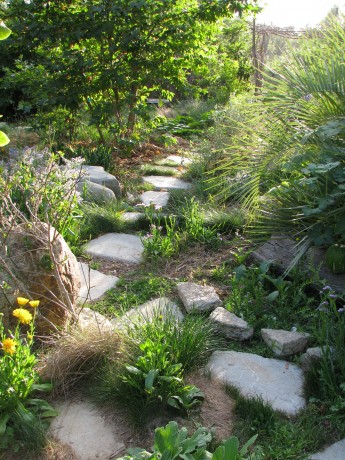
Come take a tour of a food forest! Normally tours of Finch Frolic Garden are held by appointment for groups of 5 – 15 people, Thursdays – Mondays. Cost is $10 per person and the tour lasts about two hours. By popular demand, for those who don’t have a group of five or more, we will be hosting Open Tour days for the first 15 people to sign up in August and September. They will be Sunday, August 10 and 24, Sept. 7 and 21, and Thursdays August 7 and 28, and Sept. 11 and 25. Tours begin promptly at 10 am. The tours last about two hours and are classes on basic permaculture while we tour the food forest. I ask $10 per person. Please reserve and receive directions through dianeckennedy@prodigy.net. Children under 10 are free; please, no pets. Photos but no video are allowed. Thank you for coming to visit! Diane and Miranda
- Animals, Bees, Birding, Chickens, Cob, Compost, Composting toilet, Fungus and Mushrooms, Gardening adventures, Health, Heirloom Plants, Hiking, Humor, Living structures, Natives, Natural cleaners, Other Insects, Permaculture and Edible Forest Gardening Adventures, Pets, Photos, Ponds, Predators, Quail, Rain Catching, Reptiles and Amphibians, Seeds, Soil, Water Saving, Worms
Finch Frolic Facebook!
Thanks to my daughter Miranda, our permaculture food forest habitat Finch Frolic Garden has a Facebook page. Miranda steadily feeds information onto the site, mostly about the creatures she’s discovering that have recently been attracted to our property. Lizards, chickens, web spinners and much more. If you are a Facebook aficionado, consider giving us a visit and ‘liking’ our page. Thanks!
-
Salton Sea

Salton Sea is a terminal sea; there is no connection to any other water Salton Sea is a terminal sea, created by accident in 1905 by a break in an irrigation canal from the Colorado River.

Trains a hundred cars long pass by regularly Salty and as it evaporates, becoming saltier, the sea hosts water sports, camping, and in the summer black flies by the millions, temperatures well over 100F, and the smell of rotting fish. However it is also one of the birding hotspots of the United States, as it is located along the Pacific Flyway in the Imperial Valley.

Black-necked stilt My daughter and I took advantage of the cooler post-Christmas weather and drove there last week. Winter is the best time to see birds and we weren’t disappointed.

Great egrets rest in the trees by the Visitor's Center The drive was a little over two and a half hours from our home, skirting the mountains and into the desert communities.The Sea is about 35 miles long, and is about 227 feet below sea level. The north-west part of Salton Sea hosts the visitor’s center and some good birding areas, but the best areas for us were about thirty miles south (it isn’t called a sea for nothing!) at the Sonny Bono Salton Sea National Wildlife Refuge, Unit #1.

Pelagic birds dining at Sonny Bono Fish die-off is a sad part of the life cycle of the mineral-heavy sea, and the sand is layered with the decomposing bones of millions of fish.
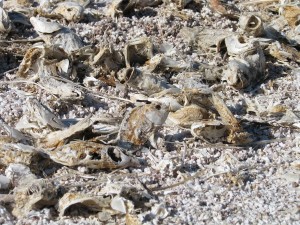
The sand is made of disintigrating fish bones Thousands of birds in enormous flocks can be seen all around the Sea. It is a grand thing to witness; it had been a common sight until fairly recently in US history to have flocks of birds so dense they blacken the sky.

Catching afternoon sunshine between feedings There weren’t that many there, but the numbers were amazing. In the southern part are agricultural fields where we saw hundreds of curlews and ibises feeding between the crops.
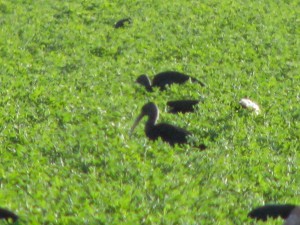
Ibis in agricultural fields. We were looking in particular for burrowing owls, and the advice we were puzzled to receive was to look in irrigation ditches and pipes along the road. Then, sure enough, as we were driving my daughter suddenly caught sight of one sitting alongside the road at the top of an irrigation ditch! He obligingly posed for many photographs. Later I saw two sitting at the opening of a pipe that protruded from an irrigation ditch! Amazing.

Burrowing owls nest in irrigation pipes One of the highlights for me was seeing sandhill cranes. These beautiful and majestic birds were feeding in ponds adjacent to flocks of pelicans. I didn’t happen to get any photos of them although my daughter did, because I was busy crawling under the car trying to find the source of the intense squealing sound that suddenly developed (only gravel in the wheel, thank goodness!) There were also hundreds of snow geese, and long strings of hundreds of red-winged blackbirds filled the sky as the sun set.

The only sound was the whisper of hundreds of blackbird wings overhead. We left, entranced, at sunset, and took the route home through the Anza-Borrego desert, up to 4,000 feet above sea level through the mountain town of Julian and back to Fallbrook in just over 2 1/2 hours. We covered about 275 miles that day, but it was well worth it for birding. The visitor’s center has many pamphlets on other birding areas in the vicinity, but they’d have to be done on other trips because there are just too many birds to see in one day!

The beautiful Gambel's quail Other birds we saw included Bonaparte’s gull, American Avocets, Stilt Sandpiper, Long-billed Dowitcher, and Gambel’s Quail, to name a few. An excellent birding site with Salton Sea bird list and locations is htttp://southwestbirders.com. Search for Salton Sea.
-
December in Fallbrook
Coots on the pond Sunlight in the sleeping willows. Tranquility (try not to look at the houses). Tough and determined roots being fed by decaying golden leaves. An impromptu Christmas tree: a snag decorated with juniper, cranberries and bird seed. Lush green weeds keeping a low profile in the winter. Stately sycamores; their leaves shed to keep their roots warm. A season of greens, golds and blues. Coyote bush seed fluff glowing white instead of snow. -
What I Did on My 50th Birthday
Waking up again in Oahu, I met my son for brunch at the Sheraton Waikiki. I was there last about 14 years ago with my young children and my aging parents, and for the first time about 39 years ago with my parents on a business trip. I remember the dining room because between the large glass panels that separate the outside from the inside, there is nothing… only space. No screen doors. House sparrows come and go, and there are no flies. It made such an impact on me when I was young, that concept of bringing the outside inside and the absolute freedom of having no bug or weather problem, that I’d always remembered that room but didn’t realize where on the several islands we visited it was until yesterday. The buffet caters to international tastes, so there is a Japanese area with miso soup, seaweed, tofu, pickled cucumber and plums, and many other goodies. There is a salad area, a cheese area, an area with assorted breads and freshly made pastries, the hot foods sections, fresh fruit and yogurts, and cereals. Throughout all this is the taste of the isles: fresh pineapple and papaya (it doesn’t taste as incredible anywhere else in the world), coconut syrup for the taro flour french toast, loco moco (egg on Spam on rice covered with brown gravy), guava juice, passionfruit pastries. There is no way to just eat a little, and no way to eat everything you’d like to.
Afterwards we walked along the beach back to the Moana, then drove out to the Manoa Falls rainforest, not far away. As soon as we got out of the car it began to pour. We purchased cheap rainjackets and mosquito wipes (don’t come to Hawaii without mosquito repellant!) and took the long, slippery, muddy and breathtakingly gorgeous hike up to the falls and back. The Manoa Arboretum is above and we walked around their pathways enjoying the incredible flowers. There are side trails up to the falls, and many pathways around the arboretum that we didn’t have time to hike. My son had to work at 5, so very muddy, we headed back towards town. We stopped at a Chinese restaurant and ate, then after leaving my son, I returned to my hotel. I was lucky enough to speak to my daughter for a long time, reply to many wonderful well-wishers on Facebook and a few emails as well. Then I dressed in one of my new Hawaiian dresses and walked with the crowds up and down the street, watching street performers doing magic tricks, balancing basketballs, pretending to be silver or gold statues, and playing electric violin to the radio. It was just the kind of day I’d hoped for. I spent it with one of my children doing something fun and adventurous, had great food, great exercise and a new start on life as I begin my next 50. Saturday, the 22nd I fly home.
-
More Oahu
As the time is three hours ahead of San Diego time, and being an early riser anyway, I’m up at 5 am with the dawn chorus. I’m able to walk out onto the beach in the dark, do my yoga stretches in the sand, swim a little in the man-made coves which create safe swimming areas away from the riptides, and watch the sun brighten the day. On Wed. we drove to the North side of the island, to Waimea Falls botanical park. An incredible collection of plants arranged in gardens representing the flora of different islands. It was very humid but lovely. We ate the now-warmed leftovers from dinner at the Cheesecake Factory in the car down the road at Shark Cove. There are incredible tidepools there. We waded, taking care not to slip on the craggy lava rock. I collected an impressive array of mosquito bites, but I”m always happy to contribute to local sustainability. Then we drove around the Eastern perimeter of the island, which is where the Hawaiians live. Incredible, majestic scenery. The mountains have real presence. When it looked as if we were going to drive around a curve directly into the mountain, there was the Wilson tunnel. Then we popped out to the other side with a completely different view, and on back to Waikiki. In the interest of time I’ll post the photos gallery style below.
Dawn Diamondhead as the sun rises in back of it Daylight reaches the hotels Paddleboarding, by the people who invented surfing Wailea Falls Monkeypod trees Water gardens Beautiful flowers Who says trees aren’t alive? Vines like a barberpole Heliconia Another beautiful ‘meadow’ Shark cove tidepools Parrotfish through the water Fishes and light Don’t worry, be crabby A sea cucumber or slug Yes, these craggy mountains are full of spirit What a backyard view for the native side of the island! I didn’t know it, but we’d be going under these mountains! Watch a video going the other way at http://www.youtube.com/watch?v=J671kJA_HRo Sunset on incredible mountains -
Traveling Again: Oahu

Oahu from the air I’m visiting my son in Oahu for a few days… good excuse, huh? After some of the usual flight and traveling difficulties, and some very welcome sleep, I’m sitting in my pre-dawn hotel room listening to the morning chorus of birds and Waikiki traffic. This is my fifth time visiting the isles; my third here. All over the hotel, the beach, the vendors is a memory of being here with my parents at various stages of our lives. My mother loved Hawaii so much. So different from shoveling snow in New Jersey layered in sodden cold clothing. If she had more than one life to live I’m sure she and Dad would live on Maui. I was here last with them when my children were small, just after my divorce. It feels like a hundred years ago. As it is, I’ve left the mainland as a woman who is forty-something, and returning a fifty year old. I need the warm scented breezes to cushion the impact.
Waikiki is like any American resort: expense and commercialism and pretense of class turning its back on the dirt, pollution, noise and poverty that seeps through cracks from the other side of the International Marketplace just across the street. Tourists shouldn’t roam far at night. Making Hawaii a state did it no favors; I agree with the natives that they’ve lost so much. Next time that I visit it will be to a bed and breakfast in the hills where there is greenery, birds and quiet.
Today we’ll go to one of the beautiful areas of the island and see some of that incredible nature that clings on to this poor volcanic rock. Hike and birdwatch and listen to the lack of human machines, if possible. Feel the freedom of not being in competition with slender young women, for at my age I am invisible, which is comforting. Let the scent of the flowers seep inside. Enjoy the company of my son as an adult. Here are a few photos of my first afternoon here:
A very long airplane wing, with Oahu below Pearl Harbor from the plane Orchid lei The historic Moana Surfrider Rockers out front Old Banyon tree in courtyard of hotel My room at the Moana Surfrider Banyons Banyon trees at the International Marketplace Where I bought a tofu spring roll snack Hu-la-lu ice cream, featuring pineapple, coconut and other tropical flavors Birds, mostly invasive species, feeding on seed in a park Waikiki and Honolulu Waikiki and Top of Waikiki revolving restaurant Oahu from the air -
To Land’s End

The Land's End Hotel This will be the last of my Cornwall travel experiences: Land’s End. At the very south-west tip of Cornwall is Land’s End. When you stand at the clifftop of Land’s End and face west, the next main body of land is the east coast of the United States.

No main land until the USA It was astoundingly beautiful, with cliffs full of history, danger and excitement. We stayed at the Land’s End Hotel (http://www.landsendhotel.co.uk/) which perches at the edge of the cliff.
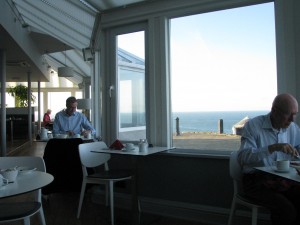
Breakfast in the dining room with an incredible view 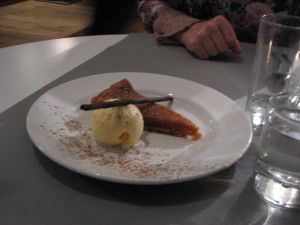
Treacle Tart... yum! The dining room windows and our room window faced the ocean and the setting sun.

Sunset over the Isles of Scilly From the hotel you could see a small group of rocks and a lighthouse.
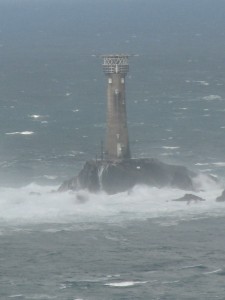
Many a sailor's saviour I watched both the moon and the sun set every day we were there.

The moon setting pre-dawn from our room On good days you can see the outline of the Isles of Scilly, which we regretfully didn’t have a chance to visit. Although we still were buffeted about by the remaining winds of the hurricane the weather was beautiful.
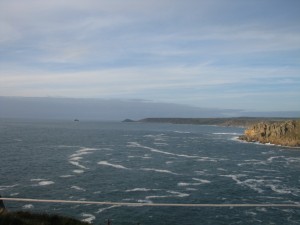
Wind-tipped waves In Cornwall they say that if there are clouds on the horizon it is going to rain, and if there aren’t then its raining already. We had some predictable showers, most notably in the morning, but nothing to complain about. And the sea… oh, the sea! We spent our last morning there walking the cliff paths between rock and heath, which even in September were quilts of purple and yellow flowers.
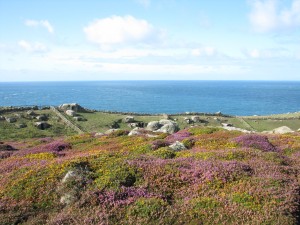
Gorse and heather in glorious bloom The rock breaks into large chunks rather than crumbling away, which creates massive natural sculptures on which you can imagine giants of legend sitting, chin on fist, mesmerized by the waves.
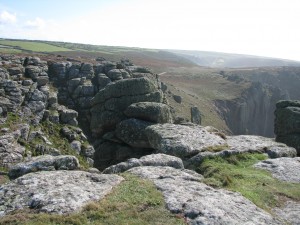
Rocks like giants' chairs The relentlessly pounding surf formed caves which made the waters home to smugglers.
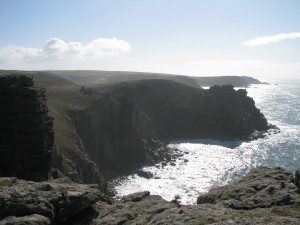
These be smuggler's waters! 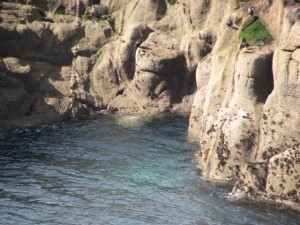
Natural caves were great for smugglers The giant rock cliffs formed enormous tombstones for the countless sailors of countless ships, all foundered on the hidden stones by wild tides, since man first took to the sea.

No guardrails on the trail to disturb the beauty The cliff pathway followed the edge without restraints or hand-holds of any kind, and it led all the way to the historic southernmost town of Mousehole (pronounced MOWzzle).
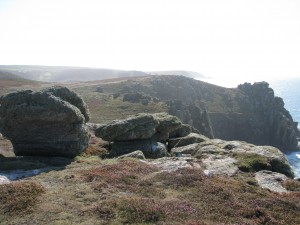
The cliff path leads several miles to Mousehole Although the wind kept the number of birds low, there still were the pelagic inhabitants using the cliffs for protection and warming themselves in the sun.

Seabirds resting 
Rocky islands are perfect for seabirds A RSPB (Royal Society for the Protection of Birds) center sat in the hotel complex on the cliff from where my daughter sighted a peregrine falcon.

RSPB Center, with an inviting Blue-footed Booby at the entrance The area around Land’s End is mostly empty, with a few farms and another historic hotel The First and Last (depends on which way you are going!) which boasts of a smuggler’s tunnel to the sea and the horrible end of the woman who turned them in to the Crown.

Epitaph for a squealer There are people who travel from Land’s End up to the farthest point on mainland Britain, John O’Groats, and call themselves End-to-Enders. Many do it for charity; some walk or bike. When we visited Scotland several years ago we took the ferry from John O’Groats to the Orkney Islands, so we’ve been at each end, just not in direct line. This Cornwall coastline is the most dramatic I’ve ever seen.

Incredible colors and textures I left part of my heart in Cornwall; something in the heartiness of the people and creatures that live there, braced against the wind and weather, calls to me.

A tough bunny I could have spent days like the giants, staring out at the roiling waves, watching the next storm blow in.

Mesmorizing As long as I could be inside nice and cozy when it hit! I want to thank my daughter for the use of many of these photographs, and for being such a good traveling companion and navigator.

Sunset -
St. Michael’s Mount

St. Michael's Mount Back to travel photos! While in Cornwall, we had to go to the coastal city of Penzance (because one of our favorite Gilbert and Sullivan plays is, of course, The Pirates of Penzance). From there we walked to the neighboring city of Marazion (don’t do this… drive!) to see St. Michael’s Mount http://www.stmichaelsmount.co.uk/ . From about 350 BC the Mount was a place where much trade took place, especially in local tin. Smuggling, too, I’m sure. Then in 495 AD some fishermen saw on the rocky island the vision of the angel St. Michael. Not long after a chapel was built and religious pilgrams flocked to the Mount.

An imposing structure A priory joined the chapel and the old, glorious castle appeared, jutting out of the hard stone and overlooking everything. Although a place of worship, many times in its history did the Mount have to take arms. Most notably it was from St. Michael’s Mount that the first beacon light was lit to warn of the Spanish Armada.
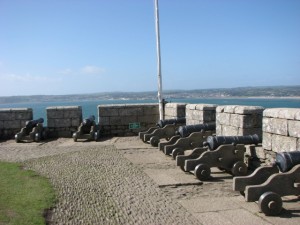
At some times the priory saw battle. After the Dissolution, it was purchased as the home of the St. Aubyn family, which it has remained ever since. In the 1950’s one of the family gave the structure into the hands of the National Trust, with the codicil that the family could live in it for 999 years. What makes St. Michael’s Mount very special is that it can be walked to across a causeway when the tide is low; when the tide covers the cobblestones, it becomes and island. We’d come to know about the causeway as it was used the in movie version of Shakspeare’s Twelfth Night.
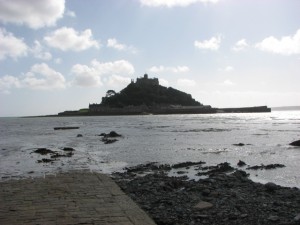
The causeway underwater We walked across the ankle-twisting cobbles to the imposing and ancient fortress.

A ruined gatehouse, with the causeway far below. We were still experiencing the very heavy winds from Hurricane Irene, so at times sand blew into our faces and it was a little hard to stand. Otherwise it was a clear and gorgeous day. Although still a private residence most of the castle can be toured.
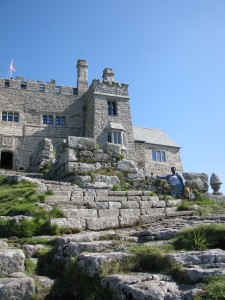
The 'front door' of the castle, facing west. 
Legend has it that a giant once lived on these giant stones. There is a grand library, and the place is rife with window nooks with the most incredible views of the English Channel.
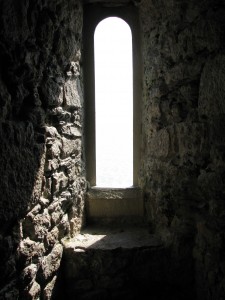
A stony window seat. The amount of labor that went into building these stone fortresses,
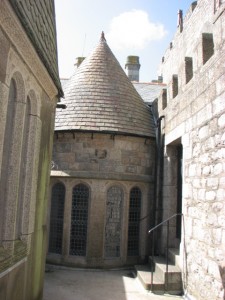
Beautiful and centuries-old workmanship. to make them last for centuries, always amazes me.

At the top of the priory The chapel boasts a rose window dated from the 15th century,

The Rose Window in the chapel as well as other fantastic artworks.
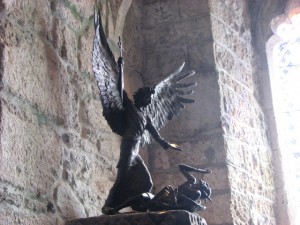
Artwork in the chapel In every room there are displays of beautiful handicraft,

Ornate sugar spoon and some unusual furniture.
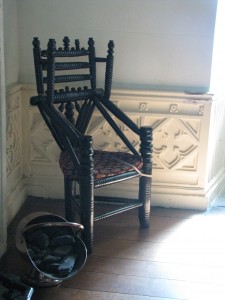
An unusual chair Below the castle are sub-tropical gardens, which were closed the day we were there. We peered down at them and discovered… a good portion of the plants we have here in San Diego!

A view of a window nook, the gardens and the Channel. 
The sub-tropical gardens in temperate Cornwall When we were to leave, the water had just begun to cover the causeway. Some souls were crossing but getting their feet wet as the winds brought the tide in quickly. We waited for a boat ride and for only one pound fifty pence (!) each, we could achieve the mainland!
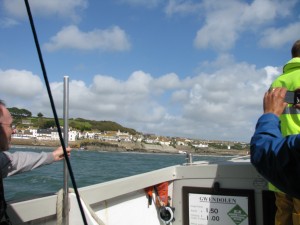
Heading back to shore. The water was choppy but we were with people who joked a lot, which we often found to be true in our British travels, and that made the crossing fun. There are festivals held on the Mount, along with re-enactments and garden tours. Check their website for announcements if you plan to visit, and keep an eye on the tides!

